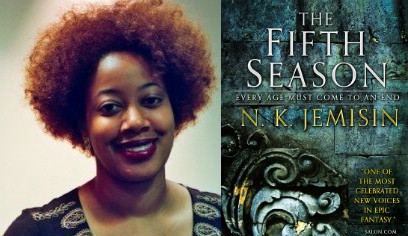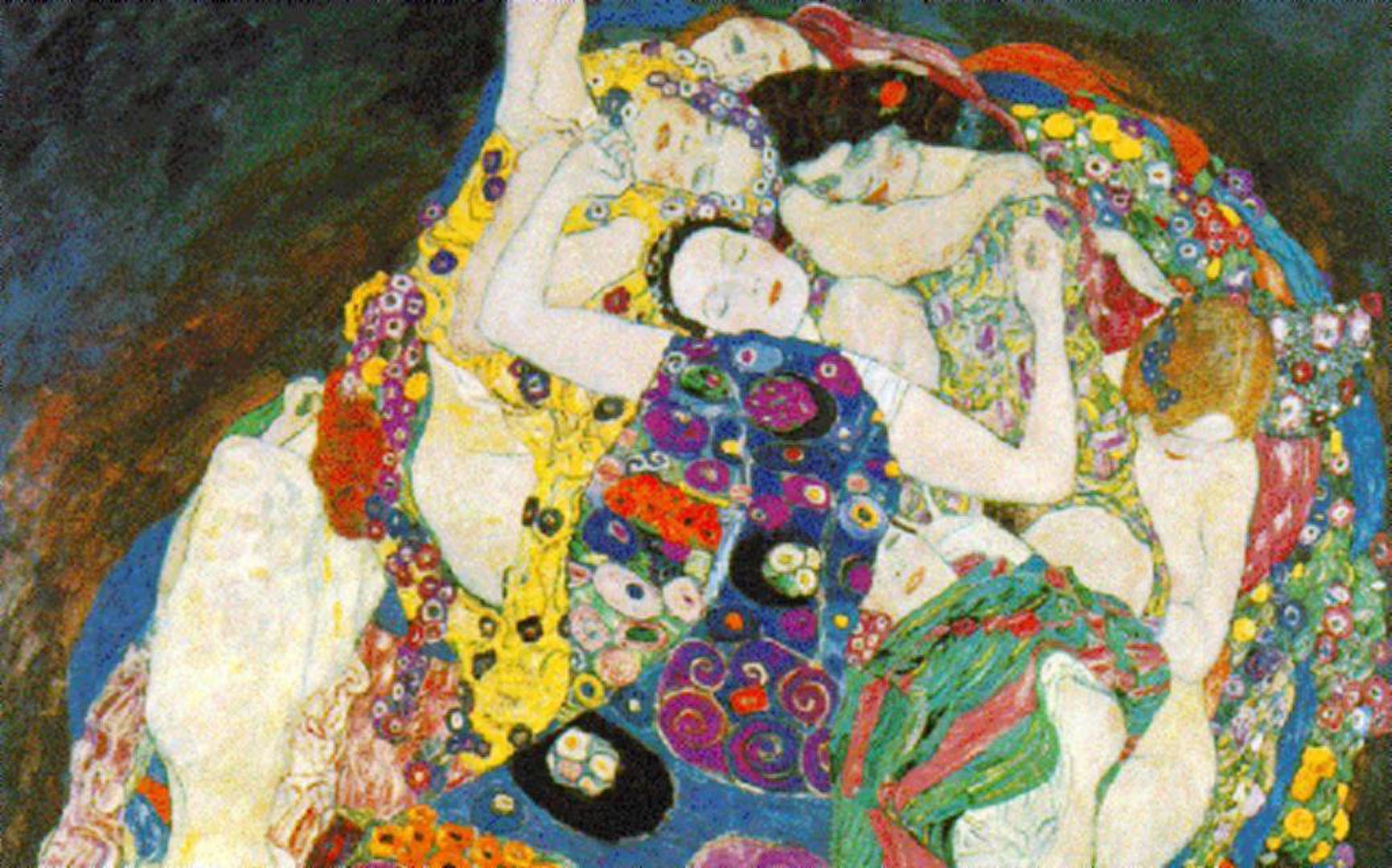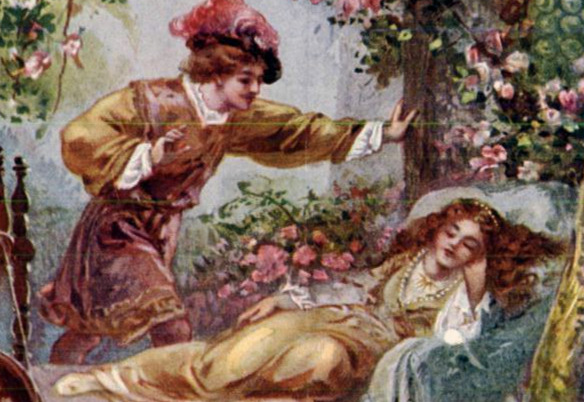Interviews
They Are Living Their Own Myths: An Interview With N.K. Jemisin, Author Of The Fifth Season

N.K. Jemisin’s fiction unfolds in unexpected ways, and her latest novel, The Fifth Season, displays this on multiple levels. It’s the first book in a trilogy, The Broken Earth. That title can be taken literally: it’s set in a world in which the ruins of former civilizations and empires provide the backdrop and, in some cases, literally loom over the action. Essun, the novel’s central character, goes in search of her missing daughter. She is also, the reader quickly learns, able to manipulate seismic energy, an ability that has also left its impact on her world. Did I mention that it’s also one of the most impressively-structured books I’ve read in a long while? Over the course of the novel, three distinct plotlines manifest themselves, and the elegance with which they converge is impressive to behold.
Jemisin’s previous work includes The Inheritance Trilogy and the two books that make up The Dreamblood. Her books blend moral complexity, worldbuilding on a grand scale, and characters who are forced to make impossible decisions. All of these subjects came up in a conversation that we conducted over the phone. An edited version of our conversation follows.
TC: In the acknowledgements of The Fifth Season, you mentioned that the book had its roots in a NASA program at which you’d had a residency. Was there any part of the book that predated that?
NKJ: It’s hard to answer that question. Pretty much nothing that I come up with is that individual, for lack of a better description. Pieces of ideas come from things that I do and they may gel together years later to become something useful. That’s what happened in this case. The NASA thing helped, and probably was one of the pieces that helped me understand the environmental aspect, the worldbuilding. The story didn’t come together until much later, when I had a character that popped into my head; that was from a dream.
TC: In the author Q & A that appeared in The Dreamblood, you talked about what the planetary structure was. I grew up reading science fiction and fantasy, but had never really considered the planetary nature of what were, essentially, fantasy worlds. How much of that needs to be done before you can start working on a project?
NKJ: A lot of it, I put together as I’m working on it. Ultimately, for me, I’m a character-focused writer. The worldbuilding is something that interests me, of course, but the thing that makes it start for me is having a character. The worldbuilding informs the characters. Looking at the mechanics and dynamics–for example, with The Dreamblood, the first thing that pops into my head was a character creeping into someone’s room in the dead of night to kill them for a religious purpose. I had no idea what the religious purpose was; I had no idea what the religion was. I just knew that I wanted a vaguely Egypt-like society and killer ninja priests.
Then I tried to think about what the religion would look like, and I was contemplating that there would be this giant, weird-looking moon in the sky. That created a lot of the symbology and the magic system, because whatever people are exposed to is what they tend to shape their ideologies and philosophies and so forth around. That’s my own belief; it’s what we see in the real world. It’s how I tend to do things. I don’t know how to tell you how I do it beyond that.
TC: You’ve written one trilogy and–would “duology” be the correct term for The Dreamblood books?
It was, maybe, ten years ago, but it was in the days when people believed that black people didn’t read, and that a book containing primarily black characters wouldn’t sell.
NKJ: Kind of, yeah. With The Dreamblood, I intended to make a trilogy. The Dreamblood books were my first publishable book. They’re what got me my agent, but they did not get published at first. They made the rounds of the houses in New York, but for whatever reason–actually, they told me… I have some feelings about those reasons. In a couple of cases, they told me that they didn’t know what the audience for that would be. It was, maybe, ten years ago, but it was in the days when people believed that black people didn’t read, and that a book containing primarily black characters wouldn’t sell. So I put those aside and I worked on The Inheritance Trilogy. By the time I got back to The Dreamblood, and by the time I was established enough to sell it, I had fallen out of love with the series. I didn’t feel like I could do a third book, so that’s why it became a duology.
TC: Do you have a sense of where events will fall when plotting over multiple books?
NKJ: It really varies, depending on the project. For The Inheritance Trilogy, because I was disillusioned at that point, I decided to write is a standalone. But as I was writing it, it occurred to me that the resolution of the first book was not really the resolution of the overarching issue. I fixed one problem, but there was a much bigger project that needed to be resolved, and I knew that I could write a second and third book. I made the first book standalone and ready to go and gave that book to my agent to try to sell, and I told her that I was willing to write books two and three. Somewhere along the way, the publishers that were interested kept asking, “Can you write another one? Can you write three?” And then it was a trilogy. It was not an intentional thing. I have vague ideas when I outline. Sometime I forget that I have an outline and then I pants it for a while and belatedly remember that I was supposed to be doing a particular plot and try to fix it and it goes all over the place. It depends on the project.
TC: Did you know from the outset that your current project would encompass more than one book?
NKJ: I knew that in this case, I set out to do something that I had never done before. Well, several things that I had never done before. In particular, I wanted to follow the same person through a fairly long saga. I’d been writing epic fantasy that I think of as inspired by actual epics–i.e. the epic form from Gilgamesh, and so on. Those are usually essentially serial tales, although they’re not necessarily told in order. Successive tales of particular heroes going through various trials and so forth. In the case of The Inheritance Trilogy, I decided to do that with the gods as the focus of the story, and following particular characters as they interact with them. The only point that remains throughout all three books is the pantheon.
With The Dreamblood, the focus was the city. The only singular point that would have remained through all three books was the fate of the city, and all of the different things that happened to it. With this, I want to follow a singular person through, essentially, the labors of Hercules. Over the course of the trilogy, she has to fix something on a literally global scale. And that will ultimately be what she has to do in order to achieve that personal resolution. Because I knew that I was going to follow the same person through a lot of trials and tribulations, I knew that was going to be more than one book. I wasn’t sure how many, but it’s easy to sell a trilogy, so I went with the trilogy.
TC: One of the joys of reading The Fifth Season was the way it was structured, and seeing the ways that the different subplots came together. They’re told in different ways, including in the third and second person. How did you end up deciding to structure it in this particular way?
NKJ: I read pretty widely, not just fantasy, so I don’t feel particularly wedded to the genre conventions. Fortunately, my publisher has been supportive in letting me explore, and my readers have been supportive in buying those books, so that I can continue to explore. I think that’s because the fantasy audience is not just interested in formula, as I think a lot of popular wisdom would have people believe. The experimental stuff that I have done is not that different from what a lot of the great and enduring novels in the genre have done, and things that end up changing the genre have done. I don’t think of it as being particularly unusual.
The second-person piece? I don’t know where that came from. I often write test chapters when I’m first starting the novel, when I’m playing with the character and trying to figure out what her voice or his voice is going to be. I wrote a test chapter in the second person on a whim and it worked, and I decided to keep doing it. There’s no explanation beyond that. I was really interested, because second person generally doesn’t sell too well, and a lot of readers are sort of hinky about it, so I guess we’ll see.
TC: We get a sense of some of the communities and internal politics of the Stillness over the course of The Fifth Season. Did that generally come up as you were writing it, or was there a reference that you had figured out ahead of time?
NKJ: Both. The necessity of keeping track of the various little bits of culture and world and so forth–I’ve experimented with using a personal wiki and things like that before. In this case, I just wrote a crap-ton of notes. I have a list of all the Seasons. I have a list of glossary terms that became the glossary. I always have to keep track of the various made-up words that I use. I made a map. I am not a map girl. I do not like maps. I’m apparently infamous within the genre for being bizarrely hateful on maps, but I finally had to make a map. I had to know what the geography would look like, and I needed to know what the fault lines were and things like that.
I wanted to show a society that was shaped by its environment and that was shaped by the disasters that had preceded it.
As I was working on these things, the rest of the world just started to gel. It was kind of necessary, because I needed a societal structure within which these things would happen. And the societal structure needed to show all that history that I had built in. I wanted to show a society that was shaped by its environment and that was shaped by the disasters that had preceded it. All of that came out of me thinking, “This is a society that periodically loses power, loses water, and where it’s very difficult to maintain central control.” This society would not be top-down authoritarian, except on a superficial level. Local control would be crucial. They would have structures in place to cause each community to close within itself and become its own enclosed, self-supporting world for a while.
So all of that went into figuring out how the society worked. They abandon capitalism during the Season, because they know that that is a danger. It’s a great way to end up with part of your population starving, and the community doesn’t have enough people to survive and to eat, and then you die. So they turn kind of hard-core communist for a brief period of time, or authoritarian, totalitarian, for a period of time. The flexibility of the society is something that I had to put together. And the rigidity of it was also there. It needed to be visible, too. I just played around with it.
TC: The structure of different characters’ names was also interesting — the way that the significance of them became apparent over the course of the novel.
You forget that it’s magic; it’s not supposed to make sense. It’s a balancing line.
NKJ: That’s standard fantasy genre stuff. Worldbuilding is a central tenet within any secondary world fantasy, and a certain subset of science fiction, too. The readership expects and demands that level of detail. There are people who will make role-playing games in a heartbeat out of your books, and if you have not provided them with predictable structures and things like that, they are going to get really pissed at you. And that can be helpful, because it makes you drill down to a level of verisimilitude that most people don’t want to think about; that can create a world with a really great lived-in feel, if you do it right. Of course, it can also be a crutch, because you’re still obsessed with creating mechanistic magic systems, which is almost an oxymoron, that can be played as a Dungeons & Dragons game. You forget that it’s magic; it’s not supposed to make sense. It’s a balancing line.
TC: The fact that the manipulation of fault lines in the novel also involves lowering the temperature, because of how energy is involved, struck me as a very interesting and resonant detail.
They are living their own myths. This is The Iliad that they’re going through…
NKJ: The idea was that I wasn’t going to use the word “magic.” Why would they call it that? Why would they treat it as something different from the way that their world works? It’s the laws of physics there. It’s science for them, so they use scientific terminology. They quantify to whatever degree they can. They treat it mechanistically. They train mechanistically. They do everything they can to systematize it. It’s not systematizable, and they recognize that past a certain point, but that won’t stop them from continuing to try to explore it and understand it, any more than not understanding how the universe was created has stopped us from trying to figure out the age of that star over there, and that sort of thing. In this case, I’m doing a secondary world whose people don’t need to emulate myths; they are creating their own. They are living their own myths. This is The Iliad that they’re going through, and then some stuff. That’s what I was trying to come up with: for the people who are living through the impossible, it isn’t impossible, because they’re living through it. I wanted it to feel like that.
TC: As you were coming up with the world’s culture and history, were there other stories that you realized that you could tell in this world if you wanted to, or that you may tell down the line?
NKJ: I’m only about halfway through it now. I’m just about done with the second book. Right now, I’m so closely focused on Essun’s story that I don’t have any others in my head. I did play around with one; I wrote a short story called “Stone Hunger” that came out in Clarkesworld about a year ago. That was a story that I did to test out the concepts of the world and to test out different characters. It’s not related to the trilogy, but it’s set in the same world. There are a couple of characters in it who have the same names, but they’re not the same people. I can tell lots of stories in the world, but no one else’s story is calling to me right now. This is going to remain a character-focused world; it’s just a question of who I want to explore. I might want to go into Alabaster a little bit, but that depends on what I end up doing with him. Stuff happens in book two.
TC: You had mentioned your reading habits earlier. Do you find that they change with you’re in the middle of writing something?
NKJ: While I’m writing something, I often stop reading for exploration or learning. When I’m reading for learning, I read a lot of nonfiction. I’ll deliberately choose stuff outside my comfort zone so that I can learn new techniques. When I am writing stuff, especially this trilogy, which is emotionally draining, I need stress relief. I read junk. On purpose. I don’t want to name the junk, because I don’t want to embarrass the authors, but–I find the crappiest schlock, and I read it. Or I find comfort fiction. I go for stuff that I know is well-written because I’ve read it before, and I read it again. My reading habits have devolved, but they’re also helping me stay on track. I don’t think it’s a bad thing.
TC: Over the course of this book, Essun has to make some incredibly horrific decisions, and is capable of doing horrific things to people. How do you balance making her relatable, while still making her a complex figure?
We’re dealing with a literary landscape in which women have to be likable to be popular. But I’m not necessarily going for popular.
NKJ: I don’t know yet. My hope is that, because I’m exploring her in full, I’m delving as deeply as possible into her. You’re seeing why she makes these horrific decisions. For me, that’s always been a thing that helps. We’re dealing with a literary landscape in which women have to be likable to be popular. But I’m not necessarily going for popular. I’m going for “keep my career alive.” I don’t need to be a bestseller. I’d like to be, but I don’t need to be. I know that, in a lot of cases, women characters are expected to be nice, or to be likable, and I know that I’m not going to be able to keep Essun likable, because she’s not in a likable situation, and she’s got to make horrible choices, as you said. So all I can do is show that there are reasons for those choices, and that those choices take a toll. She’s not doing it out of callousness or cruelty, she’s doing it because she’s backed into a literal corner in some cases. And that is taken, in some cases, from real-world events.
TC: Do you generally need to take a break after writing something that harrowing?
NKJ: Yeah. I took a break after the first book and wrote some short stories that were completely different. I wrote a novella, actually, The Awakened Kingdom, which was in the Inheritance Trilogy universe. It’s fluffy, silly, cutesy stuff, literally from the point of view of a five-year-old. I needed to write that to cleanse mental palate and do some catharsis. This whole trilogy is having that kind of effect on me. It’s been harder going than I was expecting it to be, which is one of the reasons that Orbit delayed publication of the first book. It was originally supposed to come out in August, 2014. I got it done on time, but I needed that break. I went to my editor and said, “Look, I can’t jump into book two now,” and she understood. I took some time, and I wrote some happy stuff, and I was able to get back into it.
TC: Do you have a sense of what you might be working on after the second book is done? Will there be another break in there?
NKJ: I don’t know if I’ll need as much of a break this time. The world is established; the second book is coming more easily than the first one did. Horrific things are still happening, but I think I’ve just acclimated to it by now, which is scary. I don’t have plans to take a break at this time. I plan to jump right into book three this time, and try to finish it quickly. I do have another idea for another novel in mind, possibly a YA story, and I want to get to that. I’m feeling rushed by my own imagination right now. The idea is more fun, and definitely lighter. Although it’s kind of Lovecraftian, so it’s kind of hilarious that I find Lovecraft lighter than what I’ve been writing. It’s only elder gods; it’s fine.









